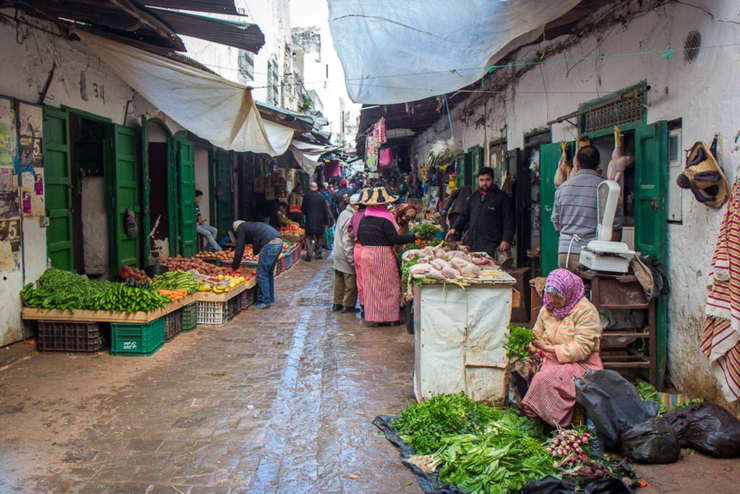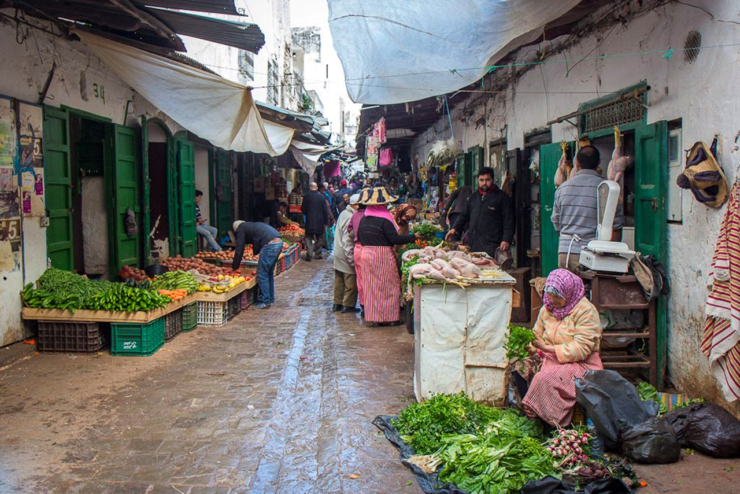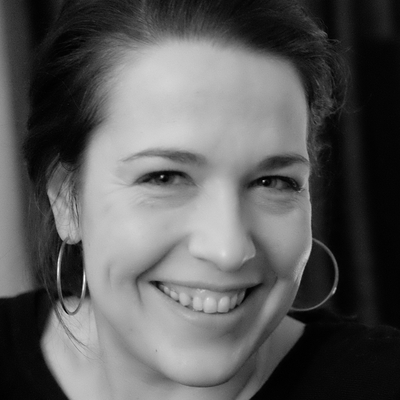For the Religious Matters project, I conduct an ethnographic study on homemaking practices among white Dutch and Flemish female converts to Islam, who have made hijra (Islamic migration) to Morocco. This group of women is part of a larger group of European Muslims (both born and converted) who, fed up with European Islamophobia and longing for a place that supports and strengthens their religion, have emigrated to a Muslim country, alone or together with their families. Food plays an important role in their creation of a sense of home in their new environment. It is also a key element in the development of their religiosity. In this blog I focus on how their food practices in a context of mobility relate to their sense of belonging and spiritual growth.

Market in the old medina of Tetouan (Morocco). Photo by Nina ter Laan, July 2018.
Salma’s kitchen
I’m chatting with Salma while she prepares me a tajine kefta mkawra (meatballs in a spicy tomato-sauce with eggs, in a traditional North-African cooking vessel made out of clay with a cone-shaped lid). The food gently simmers on a soft fire and smells delicious. After a long train and bus ride from Rabat I feel grateful for the prospect of such a nourishing meal. Her kitchen gives me a warm and cozy feeling: the natural materials used in the shelving, on which rustic wooden cooking utensils, organic products, boxes of various brands of herbal teas, and cook books filled with healthy recipes, are placed. Large printed images of colorful heaps of spices and herbs decorate the wall next to the sink. Traditional woven grocery baskets hang on over-door hooks. Stuck to the refrigerator’s door, there are magnets, drawings, postcards, and notes with personal messages.
It all feels familiar and reminds me of the kitchens of my eco-conscious friends in Nijmegen, or the anthroposophical households of our old neighbors in the town where I grew up. Their kitchens, like Salma’s, would be filled with the smell of home-made sourdough bread and herbal infusions, their walls painted in soft light colors. But in contrast to my friends and old neighbors, Salma is a converted Muslim from Belgium, who lives in Morocco: her kitchen window faces the hilly outskirts of Tetouan, a small city located along the Moroccan Mediterranean coast. I help Salma set the table with reed place-mats and Moroccan ceramic tableware, embellished with traditional designs. As I pass the kitchen door to bring a water pitcher to the dining table, I notice a printed duʿa (supplication) attached to the doorpost. It’s in Arabic, (with Dutch transliteration and translation), thanking Allah for the provision of food. Salma is unmistakably a devout cook and I am sure that what is prepared in her kitchen must be healthy, pure, and beneficial to mind, body, and spirit.
In search of Muslim normality: European Muslims moving to Morocco
5 years ago, Salma left Belgium, where she experienced insufficient freedom to practice her faith. She was tired of continuously having to defend her religion and choice to convert. Especially when she started wearing the hijab, she told me: ‘people approached me as if I was stupid.’ The shift to a halal diet and the abstinence of alcohol was equally met with much resistance and misunderstanding by her non-Muslim circles. It was also a challenge to maintain a halal diet and remaining sociable in an environment where eating non-halal food and drinking alcohol is the norm. After the coming out of her conversion, there were many places where Salma could no longer join her friends or family, as there were hardly any options:
I want(ed) to join my friends and family when they go out for dinner, but I want to dine at a halal restaurant, but then when there is only one [restaurant] in entire Gent, which doesn’t serve alcohol, then I only have one restaurant I can go to.
Several of my interlocutors conceived the limited supply of halal options, as symptomatic of secular Western societies, which some felt was hindering their spiritual search for self-fulfillment and could even harm their faith. This ignited in them a longing for a place where being Muslim is the norm, instead of the exception. This desire for what I call -Muslim normality -, is something which had motivated them to make hijra. The integration and safeguarding of Muslim dietary practices, as part of everyday life, is an important element in their search for Muslim normality. The anticipation of living in an Islamic ambiance, also referred to by my interlocutors as a ‘Muslim feeling,’ where they are able to participate fully in Islamic festivities, such as Ramadan, or the feast of sacrifice, without feeling like the exception, and not having to worry about halal meat, is envisioned as an advantage of living in a Muslim country. Additionally, within certain orthodox circles, performing hijra to a Muslim majority country is seen as a religious duty and an act of worship, which can earn them credits (hassanat) to enter Paradise.
Once in Morocco, the emigrants embrace the local foodscape in several ways. Firstly, the integration and safeguarding of Muslim dietary practices, as part of everyday life, is a very important element in savoring the much-awaited Islamic ambiance. The fact that they can eat almost everywhere, without having to worry whether the food is halal, as well as the abundance of places where no alcohol is served is a much-appreciated benefit of living in Morocco.
(…) here we can go out for dinner everywhere. There may be some places that serve alcohol, but I do not know them.
As Fatiha, a 54-year old convert from the East of the Netherlands, who has lived in Tetouan for more than 20 years told me:
Here you go to the butcher and you can assume that all the meat is halal meat. It’s like, the basic principles of Islam, they are understood and accepted by everyone, and people think it’s a good thing that you hold yourself to those principles, or are engaged with them.
Secondly, local cooking and eating habits are embraced by learning how to prepare Moroccan dishes. Most of them learn to cook the Moroccan way from female members of their Moroccan family in-law or from their housekeeper (khaddama). Another way in which the local foodscape is adopted is through its integration into an eco-conscious and ethical consumer lifestyle, which some of the women already practiced in the homeland. Several muhajirat had superfood products in their kitchens, such as coconut fat, quinoa, Himalaya salt and different kinds of herbal teas (like Pukka or Yogi teas), which they brought from their home country. They favor doing their groceries in the traditional marketplace (suq) rather than in the large supermarkets, to help support local farmers and fishermen sell their fresh products, which they see as a more pure, traditional, conscious, and Islamic way of engaging with food. These women also often take an interest in Islamic medicine (Unani – a traditional system of healing and health maintenance) and the medicinal use of foods, such as different kinds of plants, spices and herbs, which they claim to be much more available and of much better quality in the suq. When discussing these practices reverences to the Prophet (and sunnah) were often made. In such a way, they integrate local foodways into white upper-class hipster food ethics, which they regard as pleasing to God and spiritually beneficial.
A taste of home
Food and eating also gets surrounded with much tension and ambiguities. The quality of particular ingredients, the shortage of European products, and different hygiene standards can be a source of frustration and critique. Some of my interlocutors were even mistrustful towards the observance of the local halal meat status. Amal, a 26-year old convert from Belgium living in Tangiers, shared with me her doubts whether certain foods in Morocco are actually halal:
Amal: In Morocco, not everything is halal. One day, when I was walking to my work, I saw a small cart selling chicken meat, with images showing how these chickens were slaughtered, [to show] that [it was] halal. (…) I don’t know whether you are familiar with how halal meat normally is supposed to be slaughtered?
Nina: The animal has to bleed empty and a prayer needs to be said, right?
Amal: Yes, there has to be said bismillah, you have to put the animal on its right side towards Mecca and [the animal] should not see the knife, [it] has to be calm. [But] the images on that chicken cart (…) of how they slaughtered the chickens, [it was] just like in Europe, like all those chickens hung upside down next to each other on a shackled line, (…), like really weird, I thought: “What?! They call thát halal?!” So, you can actually not trust at all (…) which food here (in Morocco) is halal and which food is not.
Another food-related difficulty the women in my research mentioned, is the lack of variety of international cuisines available back home, such as Asian, Italian or Mexican dishes, as well as missing particular flavors and produces from home, such as chocolate, speculaas (spiced short crust biscuit), peanut butter, chocolate sprinkles (hagelslag), Belgian fries and waffles, chocolate, particular sauces (such as mayonnaise, curry and satay sauce), cheese, and real butter. Many complain that they get bored with the Moroccan diet after a while, which they find unvaried and bland. The absence of particular flavors from home both evoked and intensified feelings of homesickness and nostalgia, making the longing for certain kinds of food very strong.
The loss and absence of familiar flavors and products goes hand in hand with their attempted retrieval. Disillusionment and homesickness can be met with frantic attempts to get a hold of particular European products and ingredients that can give my interlocutors a taste of home. These products however are often hard to find and very expensive in Morocco. Products like mozzarella, parmesan cheese, pesto, satay, soy-sauce (kecap), in the Netherlands and Belgium are normal affordable products that are widely available in regular stores. But in Morocco these are exclusive Western luxury products, sold against very high prices in modern-day supermarkets, where only the local higher middle class can afford to shop. As a solution, the muhajirat import their much longed-for European food products either during mutual family visits, or by making regular trips to the Lidl (a European discount supermarket chain) in Melilla and Ceuta, two small Spanish enclaves on the north coast of Morocco. Others, mostly the husbands of the muhajirat, set up shops and restaurants where they make and sell their own foods.
A mixed Euro/Moroccan Muslim food culture
Expecting simple access to a halal diet as an important benefit of living in a Muslim majority country, the converts find a perplexing reality in Morocco. On the one hand, they embrace and even idealize Moroccan cooking and eating habits; local food practices are incorporated in Western trends of a pure, healthy, organic and climate conscious lifestyle, which are also seen as more Islamic. On the other hand, the quality of particular ingredients, shortage of European products, and different hygiene standards can be a source of frustration and mistrust. As a response to this puzzling reality, they incorporate various overlapping and sometimes conflicting food practices in their process of ethical self-making. They bring together European products with Moroccan cuisine, Orientalist imaginations with European eco-conscious food ethics, and Muslim piety with food nostalgia. This produces a novel concoction of smells, textures, tastes, as well as practices of purchasing, preparing, serving, and consuming food. A particular halal foodscape is thus established, which entails a hybrid taste palette, which incorporates both Islamic dietary laws and local food-practices, as well as tastes and products from the homeland. The clashing and re-alignment of tastes and sensibilities regarding food of Dutch and Flemish white converts with the religious-gustatory habitus of Moroccan Muslims, puts ideas of a Euro-Islam in a whole other light. Whereas previous discussions on Euro-Islam mainly have focused on the integration of Islam into European cultures, my research shows that what is called a European Islam has evolved along and through distinctive European national cultures and concomitant sensibilities and tastes.


